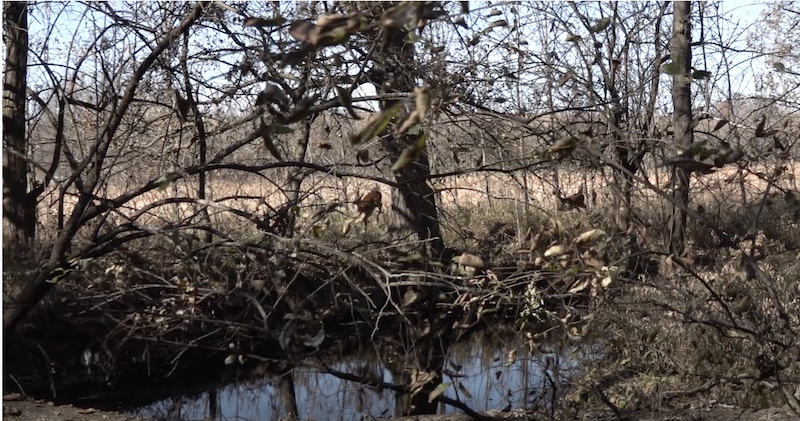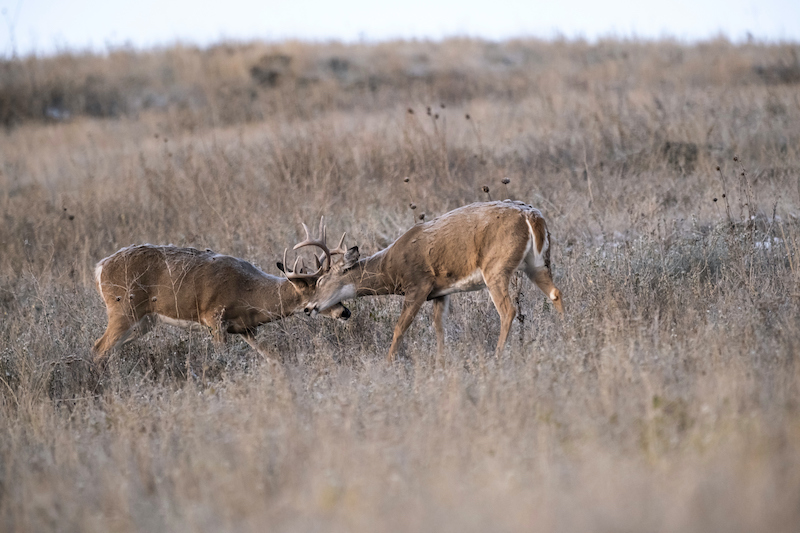Every bowhunter dreams of the whitetail rut, that magical time of year when wary whitetails – and whitetail hunters – become as giddy as children. Normally cautious trophy bucks let down their guard as they follow their insatiable urge to breed.
The rut may be one of the few chinks in a trophy buck’s armor – a fact that isn’t lost on any serious bowhunter. It’s a time when you’re just as likely to see a buck at midday as at dawn or dusk, and you may even experience the thrill of watching multiple bucks dog that first estrous doe.
Bucks know where to find does in their domain and you should, too. Identify bedding areas well before (or after) bowseason. Does hunker down most of the day in secure cover. A bedding area could be a brushy thicket, Conservation Reserve Program grass, a cattail marsh, a coniferous forest or even a bench on a ridge. No matter its location, the area provides cover and a way to keep visual, auditory and olfactory tabs on approaching predators.
Bucks scent-check these areas by approaching from downwind and cruising for does. You want to set up close enough that you’ll intercept these bucks, but without bumping does bedded nearby. For this reason, a noisy climber probably isn’t a great option. You’ll want a ladder stand or hang-on stand (set up well ahead of time) that you can quietly slip into. Using doe-in-heat scent may help attract cruising deer or at least get them to walk into your shooting window.

Hunt travel corridors near creeks or the edge of a property to catch deer between bedding areas. Photo Credit: ATA
Hunting travel corridors is another good bet. Bucks run these secure travel corridors as a way to get from one bedding area to the next. Travel corridors include the corners of abutting woodlots, brushy creek bottoms, shelterbelts, and saddles between ridges, for example. The corridors funnel deer into a narrow, concentrated area where you have an excellent opportunity to get a shot.
As archers, we’re conditioned to think in terms of close-range encounters with bucks. But during a frenzied rut, setting up where you can see a half-mile or more can be beneficial. Look for cruising bucks, then call aggressively to bring them into bow range. The idea of making a lot of noise may make you cringe. And it’s true –this technique won’t work on every buck; some will run as if they’ve been shot at, while others you never even saw may silently slip away. But a buck raging with testosterone may rush in to drive off a rival and the right to breed. Aggressive rattling, grunting and snort-wheezing can be heard from a long distance and may grab a passing buck’s attention. Couple the setup with a buck decoy. Placement of the decoy is important. The challenging buck will approach from downwind, so you want him to pass upwind of you, yet downwind of your decoy. The buck should walk toward the front of the decoy, which should be facing you. When he is turned slightly, you should have theperfect quartering-away shot opportunity. And to pull this off, managing your scent is critical.

Use aggressive buck calls to entice competitive deer. Photo Credit: John Hafner
When a buck finds a doe that smells like she’s ready to breed, he’ll stay with her for a day or two. At first she’ll run, trying to evade him by hiding in deadfalls, thickets or other thick cover. But that’s not what the buck wants. He wants her in the open where he can see and smell rival bucks approaching, because you can believe she’ll attract a crowd. For this reason, you may see a buck-and-doe pair in an open field – not exactly an ideal place to ambush a deer. In this scenario, your only option may be to stalk within range. And although the buck may be reluctant to leave his lady – even if he gets a whiff of something afoul – his doe will remain as wary as ever. Sneaking up on such a pair is no easy task, but the reward can pay off handsomely.
No matter how you hunt, anything can happen at any time during the rut. Be prepared to sit all day. That means bringing snacks, drinks, handwarmers, a urine bottle and other necessities. If you spend enough time in the right spot, sooner or later a cruising buck is going to make a mistake.